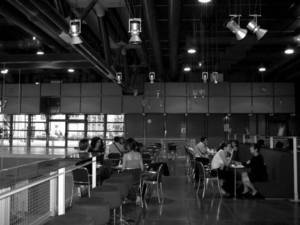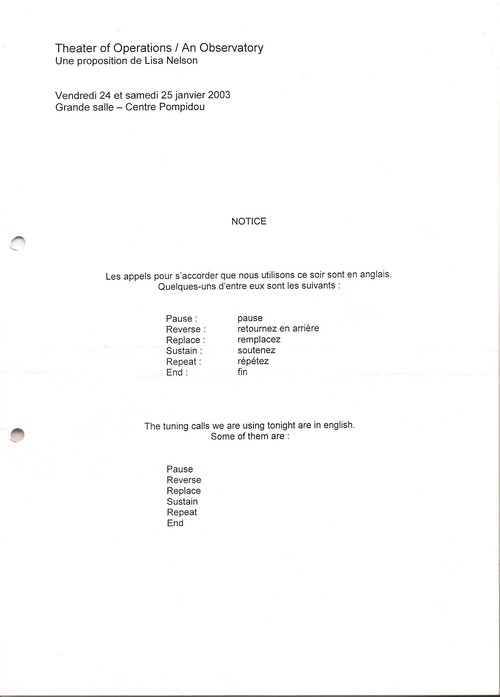LISA NELSON ON THE TUNING SCORES
“Over the course of time, two aspects of practice evolved simultaneously under the general name Tuning Scores: a solo warmup, and group and duet composition games. The solo scores are a kind of pre-technique—a physical-attentional warm-up and the inner score of the games. Sometimes referred to as tuning practices, they can be done in the studio or anywhere one finds oneself. They tune the dancer to an observational state useful to engage in the games in any depth. Though there are a number of Tuning Scores with names of their own (e.g., Blind Unison Trio, Multiple Replay, Single Image), the one referred to as the Tuning Score seems to use them all at once.”
Often described as “a communication and feedback system for a group of players”, who act equally as directors, performers, and spectators, the Tuning Score allows each player, whether inside or at the perimeter of the action, to tune the image, the time, and space in order to make meaning for themselves. Alongside their movement actions the players can resort to “calls” (like GO, ENTER, PAUSE, REPLACE, etc) to create and challenge the specificity of the moment, vector their opinions and uncover the form as it arises and sets the dance in motion.
The Tuning Score was first practiced as group explorations with Image Lab, an ensemble of choreographer/improvisors including K.J. Holmes, Karen Nelson, Scott Smith. Throughout the 1990s, Image Lab brought their work to the public through Observatories, series of site-specific performances that invited the audience to return for multiple viewings and included the participation of local artists of many disciplines. Observatories were presented in museums and art centers on both coasts of the U.S. and Canada, in Germany, the U.K. and China.
Since the late 1990’s Lisa Nelson has continued to explore the Tuning Score as a performance and research format in workshops and with different ad hoc groups in many countries. The dance GO with Scott Smith, a duet after a Tuning Score by Lisa Nelson, is one of the many examples of how Tuning Score has laid the ground for dance performances. Yet, as Lisa Nelson also indicates in the interview (see right box), the Tuning Score serves more than one application; a diagnostic tool for human behaviour at large it makes us consider movement ideas and possibilities that are normally left out of the picture, with an eye for the unravelling idiosyncracies, cultural decorum and our survival of their intricate intertwinings.
INTERVIEW WITH LISA NELSON (2003)
Listen to the interview
An interview on The Tuning Score with subtitles that disappear as words get repeated
January 26th, 2003. A noisy café on the first floor of the Centre Pompidou. Lisa Nelson just concluded a week of intense research at the Centre Pompidou, resulting in two dance performances or ‘Theatre of Operations/An Observatory’ (January 24th and 25th, 2003) and a conference (January 25th, 2003). These events form the backdrop for a one hour long conversation that honors the invention and imagination with which humans develop survival skills to cope with the socially complex crystals of conventions and individual desire.
SYNOPSIS OF THE INTERVIEW BY MYRIAM VAN IMSCHOOT
The interview begins by referring to the conference the day before and during which Lisa Nelson spoke of the ongoing construction of consensus realities that shape society. Curious for the ideosyncrasies that needs to be negotatied in the social fabric, she draws an analogy with the world of dance, which - although it’s a more confined place - reenacts similar societal dynamics and tensions. In fact, the Tuning Score gives a possibility to look at the construction of social decorum, both in its making and unmaking, and offers the tool to dissect these behavioural patterns in a microcosm.
Although the interview starts with a concrete reference to the conference, it is in the first 5 minutes that the major themes of the rest of the interview are laid out: disappearance into social norms, invisibility, survival mechanisms and the way our negotations are physically embodied and constitute complex behaviour within a sensorial array of manifestations and operations. The most frequent reoccuring term is ‘survival’. Much of the interview may be considered as cataloguing various instances in life and work that called for survival tools. The conversation switches from examples from performance practice to biographical events, life and work intertwining, as one crystal.
For instance, Lisa Nelson traces the roots of the Tuning Score to her childhood, up to teenage and adult years, recalling her shyness as a child, the perceived lack in visual and speech skills, the loss of a father, who did not return from see, or – when being an adult – living in communes, teaching in alternative ways, or being confronted with the memory loss of her mother.
Towards the end of the interview the utopian dimensions of the Tuning Score are discussed. The conversation thus returns to the social dimensions it started off from, questioning their use for experiment in small microcosms, with ripples far beyond the studio or stage. How can one built group interaction without resorting to hierarchies, distributing responsibility, while keeping a link with desire and personal motives. The interview ends with a description of a scene that emerged in a run in Paris, where performers enact a family of some sort. Here it ends, or how small shifts in performance can have giant resonance of meaning.
Program flyers
Page 2 and 3 from the Brochure January tot April 2003 for the ‘Spectacles Vivants’ at Centre Pompidou. Listed activities are the ‘Theatre of Operations/An Observatory, after a proposal of Lisa Nelson’ with an ad hoc group consisting of performers Lisa Nelson, Vera Mantero, Pascal Quéneau, Scott Smith, Steve Paxton, composer/improvisor Nuno Rebelo and dance theoretician Laurence Louppe (January 24th and 25th). In addition, it mentions a Conference (January 25th), organized by Contredanse. The latter is framed as “meeting with the public as a conclusion of a week of research, in order to draw attention to some other aspects of the work of Lisa Nelson.”
A program sheet, handed over to the audience of Theatre of Operations/An Observatory’, lists some of the calls that were going to be used in the performance, like ‘Pause, reverse, replace, sustain, repeat, end’.



